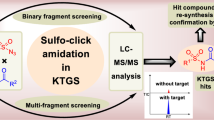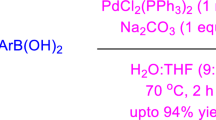Abstract
Glycine derivatives such as ethyl 2-(4-aminophenyl)-2-(phenylamino) acetate is an exciting and essential non-proteinogenic class of amino acids. Herein, we report an efficient and novel route to synthesize glycine derivatives using ethyl glyoxylate, aniline, and its derivatives catalyzed by bismuth salts. In our scheme, mild, non-toxic, and commercially viable reagents were utilized. The synthesized moieties were characterized by ESI-MASS, 1H-NMR, 13C-NMR, and XRD techniques. The target glycine derivatives were successfully obtained with a maximum yield of 87%. Moreover, the reaction is very green as water is the only byproduct.
Graphical abstract




Similar content being viewed by others
References
Beak P, Zajdel WJ, Reitz DB (1984) Metalation and electrophilic substitution of amine derivatives adjacent to nitrogen: alpha.-metallo amine synthetic equivalents. Chem Rev 84(5):471–523. https://doi.org/10.1021/cr00063a003
Chen L, Cui H, Wang Y, Liang X, Zhang L, Su CY (2018) Carbene insertion into N-H bonds with size-selectivity induced by a microporous ruthenium–porphyrin metal–organic framework. Dalton Trans 47(11):3940–3946. https://doi.org/10.1039/C8DT00434J
Liu G, Li J, Qiu L, Liu L, Xu G, Ma B, Sun J (2013) Palladium-catalyzed carbenoid based N–H bond insertions: application to the synthesis of chiral α-amino esters. Org Biomol Chem 11(36):5998–6002. https://doi.org/10.1039/C3OB41331D
Takahira Y, Chen M, Kawamata Y, Mykhailiuk P, Nakamura H, Peters BK, Reisberg SH, Li C, Chen L, Hoshikawa T, Shibuguchi T (2019) Electrochemical C (sp3)–H Fluorination. Synlett 30(10):1178–1182. https://doi.org/10.1055/s-0037-1611737
Yet L (2001) Recent developments in catalytic asymmetric strecker-type reactions. Angew Chem Int Ed 40(5):875–877. https://doi.org/10.1002/1521-3773(20010302)40:5%3C875::AID-ANIE875%3E3.0.CO;2-C
Paulissen R, Hayez E, Hubert AJ, Teyssié P (1974) Transition metal catalysed reactions of diazocompounds-part III a one-step synthesis of substituted furanes and esters. Tetrahedron Lett 15(7):607–608. https://doi.org/10.1016/S0040-4039(01)822838
Xu B, Zhu SF, Xie XL, Shen JJ, Zhou QL (2011) Asymmetric N–H insertion reaction cooperatively catalyzed by rhodium and chiral spiro phosphoric acids. Angew Chem 123(48):11685–11688. https://doi.org/10.1002/ange.201105485
Xu B, Zhu SF, Zuo XD, Zhang ZC, Zhou QL (2014) Enantioselective N–H insertion reaction of α-Aryl α- diazoketones: an efficient route to chiral α-aminoketones. Angew Chem Int Ed 53(15):3913–3916. https://doi.org/10.1002/anie.201400236
Morilla ME, Díaz-Requejo MM, Belderrain TR, Nicasio MC, Trofimenko S, Pérez PJ (2002) Catalytic insertion of diazo compounds into N-H bonds: the copper alternative. Chem Commun 24:2998–2999. https://doi.org/10.1039/B207389G
Saha B, Ghatak T, Sinha A, Rahaman SW, Bera JK (2011) Site-directed anchoring of an N-heterocyclic carbene on a dimetal platform: evaluation of a pair of diruthenium (I) catalysts for carbene-transfer reactions from ethyl diazoacetate. Organometallics 30(7):2051–2058. https://doi.org/10.1021/om200142p
Sinha A, Daw P, Rahaman SW, Saha B, Bera JK (2011) A RuII–N-heterocyclic carbene (NHC) complex from metal–metal singly bonded diruthenium (I) precursor: synthesis, structure and catalytic evaluation. J Organomet Chem 696(6):1248–1257. https://doi.org/10.1016/j.jorganchem.2010.11.003
Ho CM, Zhang JL, Zhou CY, Chan OY, Yan JJ, Zhang FY, Huang JS, Che CM (2010) A water-soluble ruthenium glycosylated porphyrin catalyst for carbenoid transfer reactions in aqueous media with applications in bioconjugation reactions. J Am Chem Soc 132(6):1886–1894. https://doi.org/10.1021/ja9077254
Deng QH, Xu HW, Yuen AW, Xu ZJ, Che CM (2008) Ruthenium-catalyzed one-pot carbenoid N−H insertion reactions and diastereoselective synthesis of prolines. Org Lett 10(8):1529–1532. https://doi.org/10.1021/ol800087p
Galardon E, Le Maux P, Simonneaux GJ (1997) Chem Soc Perkin Trans 1:2455
Aviv I, Gross Z (2008) Iron (III) corroles and porphyrins as superior catalysts for the reactions of diazoacetates with nitrogen-or sulfur-Containing nucleophilic substrates: synthetic uses and mechanistic insights. Chem A Eur J 14(13):3995–4005. https://doi.org/10.1002/chem.200701885
Baumann LK, Mbuvi HM, Du G, Woo LK (2007) Iron porphyrin catalyzed N− H insertion reactions with ethyl diazoacetate. Organometallics 26(16):3995–4002. https://doi.org/10.1021/om0610997
Holzwarth MS, Alt I, Plietker B (2012) Catalytic activation of diazo compounds using electron-rich, defined iron complexes for carbene-Transfer reactions. Angew Chem Int Ed 51(22):5351–5354. https://doi.org/10.1002/anie.201201409
Aviv I, Gross Z (2006) Iron corroles and porphyrins as very efficient and highly selective catalysts for the reactions of α-diazo esters with amines. Synlett 2006(06):951–953. https://doi.org/10.1055/s-2006-939035
Zhu Y, Liu X, Dong S, Zhou Y, Li W, Lin L, Feng X (2014) Asymmetric N-H insertion of secondary and primary anilines under the catalysis of palladium and chiral guanidine derivatives. Angew Chem 126(6):1662–1666
Anding BJ, Woo LK (2013) Iridium porphyrin catalyzed N-H insertion reactions: scope and mechanism. Organometallics 32(9):2599–2607
Mangion IK, Nwamba IK, Shevlin M, Huffman MA (2009) Iridium-catalyzed X− H insertions of sulfoxonium ylides. Org Lett 11(16):3566–3569. https://doi.org/10.1021/ol901298p
Fructos MR, Belderrain TR, de Frémont P, Scott NM, Nolan SP, Díaz-Requejo MM, Pérez PJ (2005) A gold catalyst for carbene-transfer reactions from ethyl diazoacetate. Angew Chem 117(33):5418–5422
de Frémont P, Stevens ED, Fructos MR, Díaz-Requejo MM, Pérez PJ, Nolan SP (2006) Synthesis, isolation and characterization of cationic gold (I) N-heterocyclic carbene (NHC) complexes. Chem Commun 19:2045–2047. https://doi.org/10.1039/B601547F
Bachmann S, Fielenbach D, Jørgensen KA (2004) Cu (i)-carbenoid-and Ag (i)-Lewis acid-catalyzed asymmetric intermolecular insertion of α-diazo compounds into N–H bonds. Org Biomol Chem 2(20):3044–3049. https://doi.org/10.1039/B412053A
Suzuki H, Komatsu N, Ogawa T, Murafuji T, Ikegami T, Matano Y (2001) Organobismuth chemistry. Elsevier, Amsterdam
Ketata M, Desjardins Y, Ratti C (2013) Effect of liquid nitrogen pretreatments on osmotic dehydration of blueberries. J Food Eng 116(1):202–212. https://doi.org/10.1016/j.jfoodeng.2012.10.035
So SS, Oottikkal S, Badjic JD, Hadad CM, Mattson AE (2014) Urea-catalyzed N-H insertion-arylation reactions of nitrodiazoesters. J Org Chem 79(11):4832–4842. https://doi.org/10.1021/jo500698q
Nickerson DM, Angeles VV, Auvil TJ, So SS, Mattson AE (2013) Internal Lewis acid assisted ureas: tunable hydrogen bond donor catalysts. Chem Commun 49(39):4289–4291. https://doi.org/10.1039/C2CC37073E
Ramakrishna K, Murali M, Sivasankar C (2015) Chemoselective carbene insertion into the N-H bond over O–H bond using a well-defined single site (P–P) Cu (I) catalyst. Org Lett 17(15):3814–3817. https://doi.org/10.1021/acs.orglett.5b01776
Yang T, Zhuang H, Lin X, Xiang JN, Elliott JD, Liu L, Ren F (2013) A catalyst-free N-H insertion/Mannich-type reaction cascade of a-nitrodiazoesters. Tetrahedron Lett 54:4159–4163. https://doi.org/10.1016/j.tetlet.2013.05.131
Ollevier T, Lavie-Compin G (2004) Bismuth triflate-catalyzed mild and efficient epoxide opening by aromatic amines under aqueous conditions. Tetrahedron Lett 45(1):49–52. https://doi.org/10.1016/j.tetlet.2003.10.129
Acknowledgements
This work was supported by the Science and Engineering Research Board, Government of India (File No. EEQ/2018/000428). The authors thank CIF, Pondicherry University, for the NMR spectroscopic facility and DST-FIST for the ESI-MS facility and Single crystal XRD facility. Mohd. Aamir Bin Riyaz and Premkumar G acknowledge Pondicherry University for providing University Research Fellowship.
Author information
Authors and Affiliations
Corresponding author
Ethics declarations
Conflict of interest
The authors declare no conflict of interest.
Additional information
Publisher's Note
Springer Nature remains neutral with regard to jurisdictional claims in published maps and institutional affiliations.
Supplementary Information
Below is the link to the electronic supplementary material.
Rights and permissions
About this article
Cite this article
Riyaz, M.A.B., Premkumar, G. & Swu, T. Bismuth-catalyzed arylation of ethyl glyoxylate with aniline via N–H insertion. Mol Divers 27, 167–175 (2023). https://doi.org/10.1007/s11030-022-10411-x
Received:
Accepted:
Published:
Issue Date:
DOI: https://doi.org/10.1007/s11030-022-10411-x




